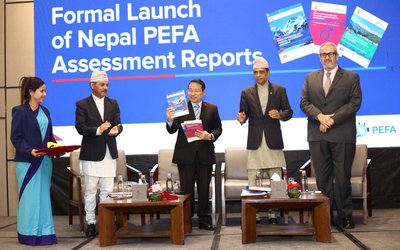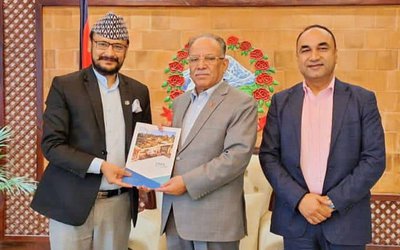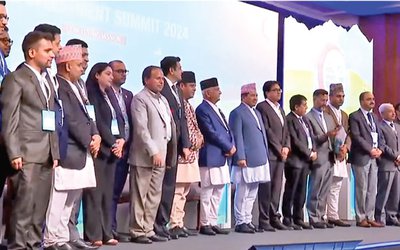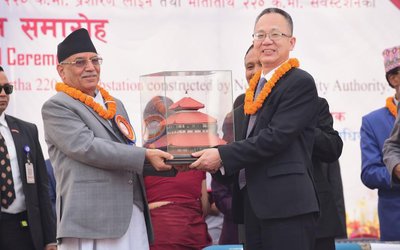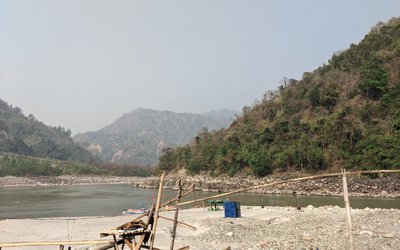Last time Nepal suffered from similar BoP crisis was back in the early 1980s. That was the time when Nepal had semi-closed economy and illiberal political regime.
Twenty-five years down the line, the country is staring down the same problem but with much more complicated ramifications.
Ramifications and consequences may be complicated but its roots are simple.
The country is not earning enough to buy its imports. Since October, the country has had to dig deep inside its forex deposits to pay the ever-fattening import bills.
The situation is not at all tenable. From last year’s position when Nepal could finance 11 months’ worth of total imports of merchandise through its forex reserve, it has now come down to 6 months.
If this slide is not halted immediately, an all-out bankruptcy cannot be ruled out, according to many economists.
And the signs are already worsening. Despite several policy efforts by the government the Balance of Payment deficit has continued to hover around Rs 20 billion.
Compare this with the fact that little over a year ago, Nepal was enjoying BoP surplus of Rs 38 billion.
Not only that surplus has vanished, but the country is now reeling under Rs 20 billion of deficit – a total loss of nearly Rs 60 billion in such a short time.
Harsh Measure
And the desperate times are spurring desperate measures.
It looks almost certain that in the upcoming budget, the government will introduce some import control.
“Our consumption growth is a big problem. The latest figures by Central Bureau of Statistics show that of Rs 100 earned, we save less than Rs 10. This is not sustainable. We have to control our consumption,” said Acharya.
As such, the government is mulling to introduce controls on imports of luxury goods such as expensive vehicles, diamonds etc.
That will be a tall order. At a time when the middle class families with disposable income have taken to the rising mall culture, controlling consumption will be easier said than done.
Why?
Many theories have been forwarded to explain the astounding loss of Rs 60 billion from the national exchequer.
The most apparent one is the huge and burgeoning gap between import and export.
“We have already imported the amount of goods in nine months in this year what we did in the whole of 12 months last year. If the rate of import growth continues, we will have trade deficit, in goods alone, to the tune of Rs 402 billion, which is 29 percent of our GDP of Rs 1182 billion,” said Dr. Tilak Rawal, former governor of Nepal Rastra Bank (NRB).
According to Keshav Acharya, senior advisor at the Ministry of Finance, earnings of the country have stagnated while expenses have spiraled.
“The remittance incomes were the main pillar behind the increasing foreign exchange in previous years. But this year, the remittance growth has come down from 65 percent to 10 percent. The exports have also decreased by 10 percent. On the other hand, imports have surged by 46 percent. This has created a huge problem for the economy,” Acharya said.
To be frank, imports had always exceeded exports and trade deficit had never gone away in the past too.
But in the past, the trade deficit was covered by the earnings from remittances and other service sector.
This time, the gap was too huge to be filled. Why then, didn’t anybody see this crisis coming?
Capital Flight
“Symptoms had shown long ago. But the authorities failed to notice them,” feels Dr. Rawal.
In fact, the emergence of a trinity of troubles – the BoP loss, liquidity crunch in banking system and unusually high import of gold – had coincided last year.
But the authorities in the Ministry and, more particularly, the Nepal Rastra Bank (NRB) were preoccupied. Nobody put the two and two together.
“The whole thing was triggered by capital flight,” confided one former NRB insider not wanting to be named.
“What happened was, taking advantage of the difference in custom duty on gold imports in India and Nepal, a huge amount of LCs were opened for their imports to Nepal. The gold came here and were surreptitiously smuggled across the border to India. But the money did not come back to Nepal. It was either invested in India or taken elsewhere from there. This created a huge hole in BoP,” he said.
Another NRB insider even contemplated that the gold may not have entered even into Nepal. “Just like a few months ago there was a scandal of foreign exchange abuse by some unscrupulous traders who opened LC to import wool from China but only did so in paper, the same thing could have happened with gold too.”
Anyway, the hole was created. And since NRB had the huge deposits of local currency against which it had provided foreign exchange to those importers, there was big liquidity crunch in the market.
Even Finance Ministry officials do not rule out capital flight as one of the roots of the problem.
“Since we have outlawed the capital account transfer, I cannot, as a responsible official, say that capital flight has occurred. But the data do point otherwise and I cannot rule this out as well,” said Acharya.
Failed Efforts
In order to stem the flow of gold, the NRB had, in February, introduced new policy efforts.
It asked for the deposit of 40 percent cash margin while opening LCs to import gold.
The government, spurred by India’s further increase in custom duty on gold, introduced an ordinance to raise its duty here.
In March, India’s Finance Minister Pranab Mukherjee increased duty on gold from IRs 20 to 30 per gram. Nepalese authorities responded by moving an ordinance to increase gold duty here from NRs 13.
“We thought we could bring BoP loss to zero by April through these measures. But it didn’t happen. We then thought it would end by the end of this fiscal year. That also doesn’t look likely,” said Acharya.
“We now believe that BoP loss is not going to vanish anytime soon. We will just bring it down gradually,” he said.
In order to overcome BoP crisis, the country has already asked for help from International Monetary Fund (IMF).
The IMF has responded by providing around Rs 3 billion of interest free loan under Rapid Credit Facility (RCF).
That if the BoP loss does not start to reduce substantially soon, the country will fall in an economic crevasse is not contested by anyone.
The authorities are now in a desperate mood.
Why?
Many theories have been forwarded to explain the astounding loss of Rs 60 billion from the national exchequer.
The most apparent one is the huge and burgeoning gap between import and export.
“We have already imported the amount of goods in nine months in this year what we did in the whole of 12 months last year. If the rate of import growth continues, we will have trade deficit, in goods alone, to the tune of Rs 402 billion, which is 29 percent of our GDP of Rs 1182 billion,” said Dr. Tilak Rawal, former governor of Nepal Rastra Bank (NRB).
According to Keshav Acharya, senior advisor at the Ministry of Finance, earnings of the country have stagnated while expenses have spiraled.
“The remittance incomes were the main pillar behind the increasing foreign exchange in previous years. But this year, the remittance growth has come down from 65 percent to 10 percent. The exports have also decreased by 10 percent. On the other hand, imports have surged by 46 percent. This has created a huge problem for the economy,” Acharya said.
To be frank, imports had always exceeded exports and trade deficit had never gone away in the past too.
But in the past, the trade deficit was covered by the earnings from remittances and other service sector.
This time, the gap was too huge to be filled. Why then, didn’t anybody see this crisis coming?
Capital Flight
“Symptoms had shown long ago. But the authorities failed to notice them,” feels Dr. Rawal.
In fact, the emergence of a trinity of troubles – the BoP loss, liquidity crunch in banking system and unusually high import of gold – had coincided last year.
But the authorities in the Ministry and, more particularly, the Nepal Rastra Bank (NRB) were preoccupied. Nobody put the two and two together.
“The whole thing was triggered by capital flight,” confided one former NRB insider not wanting to be named.
“What happened was, taking advantage of the difference in custom duty on gold imports in India and Nepal, a huge amount of LCs were opened for their imports to Nepal. The gold came here and were surreptitiously smuggled across the border to India. But the money did not come back to Nepal. It was either invested in India or taken elsewhere from there. This created a huge hole in BoP,” he said.
Another NRB insider even contemplated that the gold may not have entered even into Nepal. “Just like a few months ago there was a scandal of foreign exchange abuse by some unscrupulous traders who opened LC to import wool from China but only did so in paper, the same thing could have happened with gold too.”
Anyway, the hole was created. And since NRB had the huge deposits of local currency against which it had provided foreign exchange to those importers, there was big liquidity crunch in the market.
Even Finance Ministry officials do not rule out capital flight as one of the roots of the problem.
“Since we have outlawed the capital account transfer, I cannot, as a responsible official, say that capital flight has occurred. But the data do point otherwise and I cannot rule this out as well,” said Acharya.
Failed Efforts
In order to stem the flow of gold, the NRB had, in February, introduced new policy efforts.
It asked for the deposit of 40 percent cash margin while opening LCs to import gold.
The government, spurred by India’s further increase in custom duty on gold, introduced an ordinance to raise its duty here.
In March, India’s Finance Minister Pranab Mukherjee increased duty on gold from IRs 20 to 30 per gram. Nepalese authorities responded by moving an ordinance to increase gold duty here from NRs 13.
“We thought we could bring BoP loss to zero by April through these measures. But it didn’t happen. We then thought it would end by the end of this fiscal year. That also doesn’t look likely,” said Acharya.
“We now believe that BoP loss is not going to vanish anytime soon. We will just bring it down gradually,” he said.
In order to overcome BoP crisis, the country has already asked for help from International Monetary Fund (IMF).
The IMF has responded by providing around Rs 3 billion of interest free loan under Rapid Credit Facility (RCF).
That if the BoP loss does not start to reduce substantially soon, the country will fall in an economic crevasse is not contested by anyone.
The authorities are now in a desperate mood.
IMPORT OF CRISIS
• Nepal imported buffalo, goat worth Rs 15 billion in nine months of current fiscal year
• Bhote Lasun or Garlics from China were imported to the tune of Rs 290 million
• Top imported items include gold (Rs 37 billion); followed by petroleum products (Rs 34 billion); vehicles (Rs 21 billion) and MS billet (Rs 12 billion)
• Last year Nepal imported Rs 284 billion worth of goods in total; this year the same amount of import has already taken place in only 9 months
• This year the trade deficit in goods alone is estimated to stand at one-third of country’s total GDP
• Import growth rate has surged to whopping 46 percent
EXPORT SCARE
• In nine months, Nepal exported Rs 45 billion worth goods in total
• Compared with the total exports of Rs 45 billion, the country imported gold alone worth Rs 37 billion
• Exports have decreased by ten percent compared to last year
• Remittance income which were growing by up to 65 percent last year, is now growing by around 10 percent only
- TBM’S POPULARITY: Upper Arun And Dudhkohshi Next
- May 02, 2024
- QATAR AMIR’S STATE VISIT: Five Agreements
- Apr 28, 2024
- BIPIN JOSHI: Call For Release
- Apr 21, 2024
- TANAHU HYDROPOWER PROEJCT: A Significant Achievement
- Apr 15, 2024
- AMBASSADOR HANAN GODAR: Sharing Pain With A Nepali Family
- Mar 30, 2024


